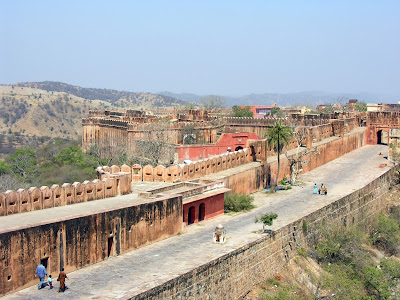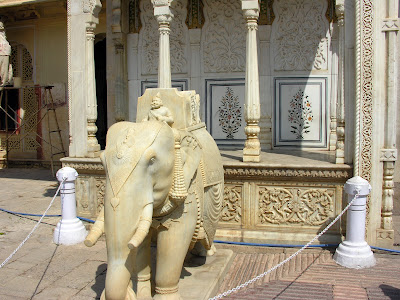Delhi, Agra and Jaipur constitute a ‘Golden Triangle’ of cities forming a major tourist attraction in India. My official duties used to take me to Delhi quite frequently and I was able to explore its tourist attractions in fair detail several times. On a few such occasions I also managed to visit Agra which hosts one of the seven man-made wonders of the world. This was the subject of my earlier blog post dated 27th August this year. I did not get a chance to visit Jaipur, capital of Rajasthan state and popularly known as the Pink City, until 3rd August 2005 on my way back to Delhi from an official visit to Ajmer. I had waited far too long for such an opportunity and needlessly so. Since I didn’t have adequate time for a leisurely walking tour of the city, my preferred style of sightseeing, I opted for a whole day conducted tour offered by the state tourism board. I have never really liked conducted tours for various reasons, one of them to do with the poor professional quality of the guide. The Jaipur tour was a major exception since I and my fellow tourists ended up in the hands of an exceptionally competent and knowledgeable guide. He was very young, dynamic, friendly and could speak English quite fluently, something rather hard to come by among official departmental guides.
The Pink City was founded in 1727 by Maharaja Sawai Jai Singh II, an extraordinarily enlightened ruler by any standards. He was also a famous astronomer and founded the great medieval astronomical observatory, called Jantar Mantar, at both Jaipur and Delhi, the one in Jaipur being larger and better known. What he accomplished in India has some modest similarities to the achievements of the great Danish nobleman and astronomer Tycho Brahe in 16th century Europe. The city itself is steeped in Rajasthani history and culture as well as some distinctive architecture.
[All pictures in my posts can be blown up to their full size by clicking on a picture and opening it in a separate window]
[All pictures in my posts can be blown up to their full size by clicking on a picture and opening it in a separate window]
Amber Palace
The main attraction in Jaipur is the palace located in the sprawling Amber Fort on a rugged hillock about 10 km from the city. Here is a picture of the fort across a water way as we approached it:
Here is a view of the quadrangle inside the fort complex with a flock of pigeons enjoying their freedom:
The following is a view of the palace from the interior. The architecture is similar to the ones seen in Agra and Delhi forts.
Pictured below is Ganesh Pol, the ornate entrance gate to the Amber palace, a stunning mix of Mughal and Rajasthani architectures.
Here is a blown-up view of the lower right portion (on the ground floor) of the previous picture showing its strikingly beautiful painting and inlay work:
Albert Hall Museum
The Albert Hall Museum, conceived on the lines of the famous Victoria and Albert Museum in London, is one of the oldest museums in the country. Surprisingly, the tour itinerary did not include a stop here and I had no chance to get a good picture of the excellent heritage building housing it. However, I managed to shoot a zoomed-in picture of its uppermost part capturing its stunning style and architecture. Here it is:
The Hawa Mahal
The Hawa Mahal is the most popular landmark of Jaipur and in some ways symbolic of the city itself. Abutting a busy street in the heart of the city, its uniquely rich exterior is in sharp contrast to a drab and dull interior. The tourist bus slowed down sufficiently for me to capture this image of the famous structure without having to get down:
Jaigarh Fort
The Jaigarh Fort, also known as the ‘Victory Fort’ is located on top of a hill about 15 km away from the city and quite close to the Amber Fort. Here is a view of this sprawling fort complex:
The Jaigharh Fort houses what is claimed to be the world’s largest cannon. To see this, one has to pay an additional entrance fee! Here is a picture of this fabled cannon:
Nahargarh Fort
Located north of Jaipur city, the Nahargarh Fort lies atop a rugged hillock and commands a great view of the city all around. Here is a picture of the older and rather dilapidated portion of the fort in the foreground against the backdrop of part of the city:
The later additions to the fort are much better preserved and house a number of beautiful structures. Here is a spectacular view of the intricate and colourful ceiling of one of them:
Here is another view of the pink city from a vantage point on the fort. The triangular structure prominently visible at the central right portion of the picture is part of the famous Jantar Mantar, the astronomical observatory built by Sawai Jai Singh.
Jantar Mantar
The Jantar Mantar observatory complex houses a number of large geometric mechanical devices mostly made up of stone for measuring time, tracking stars and planets, predicting eclipses and measuring celestial coordinates to a high degree of accuracy without employing any optical aid as in modern astronomical observatories. Preserved in very good condition, Jantar Mantar has been declared a world heritage site. Here is a picture of the largest structure, the majestic Samrat Yantra (easily recognizable in the previous picture), whose steep edge is at an angle of just under 27 degrees to the horizontal plane, corresponding to the latitude of the place. It points north along the earth’s axis and the device is part of what is considered to be the world’s largest sundial.
Our guide spent a good bit of time at Jantar Mantar explaining quite competently how the various instruments in the observatory were designed to be used. Most of what he said fell on deaf ears and I appeared to be the only tourist showing any interest in his narrations. The invisible bond between us grew stronger.
Jal Mahal
The Jal Mahal is a beautiful palace surrounded on all sides by the picturesque Mansagar lake against the backdrop of the Nahargarh Fort. Here is a picture of this taken from the roadside:
City Palace
One of the major attractions of the pink city is the City Palace Complex which has a number of spectacular and palatial buildings, with a great museum as its centerpiece. Here are two pictures from inside this complex:
The Birla Connection
The influence of the Birla group in the Pink City is underscored by two of the most famous modern buildings in the city – the Birla Mandir and the Birla Science and Technology Centre.
The Birla Mandir (Laxminarayan Temple) built in 1988 out of pure white marble like the one in Hyderabad, is a stunning sight during both day and night. At the foot of the Moti Dungri Fort housing former royalty, it is surrounded by lush greenery and large open spaces. The following picture of the temple is particularly pleasing against the background of a blue sky with white clouds. The carvings on the outside can be best seen when the picture is blown up to its full size.
Here is a picture of the main building forming part of the famous Birla Science and Technology Centre which also houses a modern planetarium, in some respects complimenting the ancient Jantar Mantar. It is a stunningly modern building with a breathtakingly beautiful architecture.
Au Revoir Jaipur
The daylong tour of the Pink City and surroundings was really long and a warm weather added considerably to the discomfort of the tourists. The trip should have terminated at the Birla Planetarium with a celestial show, but most tourists were in no mood for it and dropped out along the way. I and the indefatigable guide were the only ones who reached the destination, but I opted to spend the rest of the day outdoors rather than inside a planetarium which was no stranger to me. Before leaving, I paid a sincere and richly deserved compliment to my guide for all that he had done to make the day so memorable. On his part, he paid me an equally rich compliment by saying that at twice his age I was hardly the kind of tourist he was used to meeting. Even as I compose this post I greatly regret my thoughtlessness in not having written a formal letter of appreciation to the state tourism board for providing such an exceptionally able guide.


















5 comments:
Nice post on Jaipur.Jaipur called the pink city of india due to the presence of majestic pink structures scattered throughout the city.It is popular due to its rich culture and heritage..
Tour and Travel Companies in Chandigarh
Touritor is one of the Best online portal to Book Professional tourist guide in jaipur Rajasthan.
Nice Blog.
Book Your Perfect Tour with Touritor.
Jaipur Tour Guide
Guided India Tours
Nice Blog.
Enjoy best tour and Book Your Perfect Tour guide.
Jaipur Tour Guide
Guided India Tours
Thanks for thiss blog post
Post a Comment